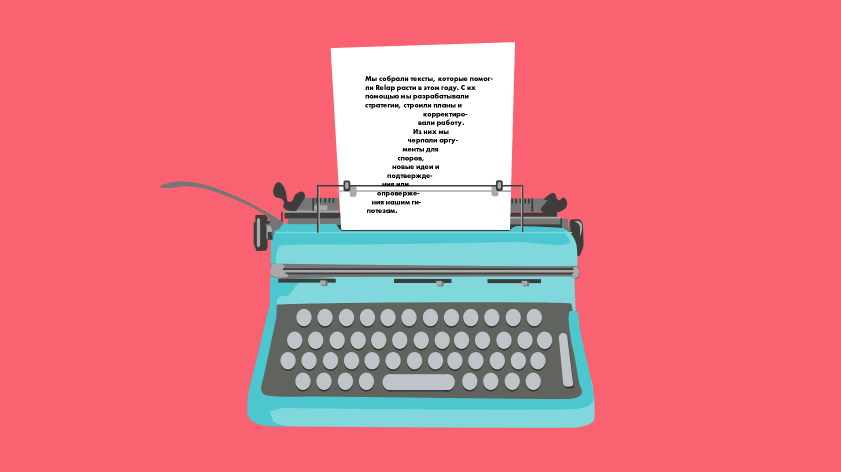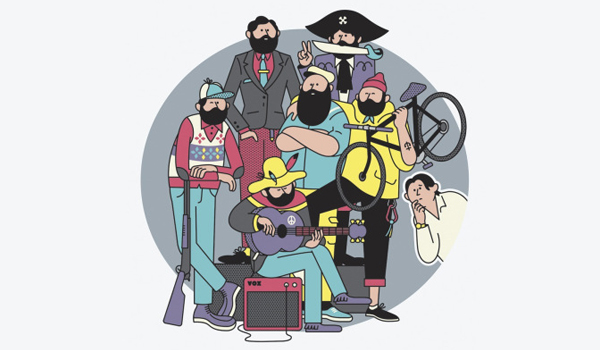7 main texts on advertising and media in 2015

Texts that helped Relap.io grow this year. We focused on them when preparing for speeches, developing strategies, making plans and adjusting work.
')
Guide for media manager, written by researcher Andrei Miroshnichenko . The media will have to live in a world where a bad viewed article is better than a good unread. Audience and traffic are not synonymous. They behave differently, they need different types of content. If you dislike seals and gifs - you risk remaining at the bottom.

Turn your audience into traffic and seals forever
Thanks to the social networks that deliver articles to the reader, we now have two types of media consumption: in the form of an audience, and in the form of traffic. The audience assumes work with loyalty, and traffic - with fluidity (this is another difference between the old and new media). The global trend leads the market from loyalty to turnover. The editor now has to study not the style, but the nature of an impulse purchase.
The history of the publication with "ugly long" high-quality texts, which was closed for unprofitability. The main corporation ESPN site "Grantland" brought 10% of regular visitors. But this audience turned out to be useless trash for business, because longreads are impossible to sell.

Long text on the death of long texts
This is not a longrid dead. Truly dead are the brains of marketers and advertisers who have been around for twenty years - the active life of the Internet - cannot come up with anything different from a banner on a page or an ad in video or audio broadcast. With the exception of new technologies (full-screen flash, which we all love so much) and ideas to show banners targetedly (for those who recently googled "ski boots" slip advertising shoes for skis, skis and tents themselves), everything else in the advertising business is a stone age . Learning to make money on those who have no desire to click on provocative headlines, on those who like to read something that does not fit into the limit of focusing a goldfish - this will require a new Edward Bernays .
To make a special project quickly and cheaply, the media lacks the process of working with the advertiser, a ready-made package of product features and formats that they are ready to offer. "Medusa" such a package has created and tells how to place advertising texts on the site, on the advancing edition to the throat.

Native advertising: why it's cool and why nobody can do it
The native is good because it is inexpensive. But many sites, having seen the new format, decide to cheat and sell the native as separate special projects - and for the corresponding money. But the new format can not be expensive - otherwise it will not be put on stream. The flow may occur when you for a little money show a serious result.
Text that can be used as a guide for explanatory journalism, copywriting, advertising, and sales. We found it in the American marketing blog and translated it. It is presumptuous to put it in a selection of “main texts”. But after reading, we made a bunch of edits to the landing page and client letters m.

So what? How to turn product features into benefits
The list of features and services are facts about your product or service. And the benefit is why the product is needed by the reader.
Imagine selling a kitchen stove. And one of the main functions is fast warming up. A quick warm-up system is a fact about the stove - what it can do.
To understand the benefits, ask yourself: "So what?".
The stove heats up quickly.
So what?
Turn on, and she is instantly ready to cook lasagna.
So what?
You can eat faster.
So what?
Life will be easier. No need to wander around the kitchen while the oven warms up. No need to worry that you forgot to include it in advance.
Text that explains the tendency for giant sharing buttons. But it's not about the buttons. Information has become available. What matters is not what you read “Vedomosti”, but how you share the materials of “Vedomosti”. For media, this means that the possibility of sharing has become a key need of the reader.

On the role of shortage and excess in the media and not only
In conditions of excess, the deficit loses value. The opposite mechanism is turned on - sharing, the ability to effectively and beautifully share (in Russian there is no suitable word yet, apparently, sharing will take root).
There is a completely different economy, where people do not pay for the right to use someone else's product, but their own emotion of participation. There is another society where political bonuses bring the creation of social services that make sharing more convenient and visible, prestigious.
2 points that should not be here

"How to write without shit." The best we saw in 2015 on this topic was written by Maxim Ilyakhov in 2014.
Quality criteria for an informational article
The author can not know everything about the topic, this is not required. But the author must understand what questions the reader will have, and find answers to them.
We lied in the title and inserted a video into the selection: a lecture by Sergey Paranko from the editorial staff of Mail.ru media projects. In order not to watch for more than 40 minutes, the main thing is that we learned from there.

Users began to read differently, what to do media?
If before the audience got to the main page of the media, and from it spread through publications (“newspaper”, analog consumption scheme), now a large proportion of readers go straight to the material page, through the issuance of a search engine or through a link on the social network, bypassing the main page.
The amount of traffic to the main pages and headings of sites is reduced, and will continue to do so. Shifting the user's attention from the rubricator and the main page to the material page changes a lot. People come to the material page and leave the resource from it. From here a conclusion: it is necessary to "cling" the user exactly here.
Source: https://habr.com/ru/post/297652/
All Articles